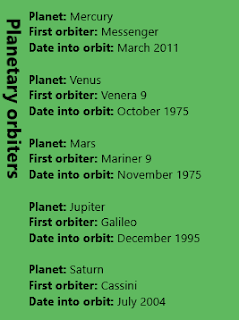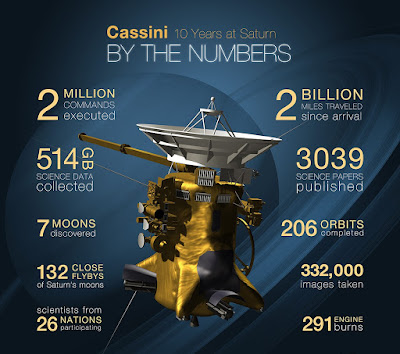A space probe is a robotic spacecraft that does not orbit Earth, but instead, explores further into outer space. A space probe may approach the Moon; travel through interplanetary space; flyby, orbit, or land on other planetary bodies; or enter interstellar space.
The space agencies of the USSR (now Russia and Ukraine), the United States, the European Union, Japan, China, India, and Israel have collectively launched probes to several planets and moons of the Solar System, as well as to a number of asteroids and comets. Approximately 15 missions are currently operational.
Some space probes names:-
Luna 9
First man-made object to soft land on the Moon, or any other extra terrestrial surface.
Luna 3
First mission to photograph the far side of the Moon, launched in 1959.
Luna 16
First robotic sample return probe from the Moon.
Lunokhod 1
First rover on Moon. It was sent to the Moon on November 10, 1970.
Mariner 10
First probe to Mercury.
Venera 4
First successful in-place analysis of another planet. It may have also been the first space probe to impact the surface of another planet, although it is unclear whether it reached Venus' surface.
Venera 7
The Venera 7 probe was the first spacecraft to successfully soft land on another planet (Venus) and to transmit data from there back to Earth.
Mariner 9
Upon its arrival at Mars on November 13, 1971, Mariner 9 became the first space probe to maintain orbit around another planet.
Mars 3
First soft landing on Mars (December 2, 1971) The lander began transmitting to the Mars 3 orbiter 90 seconds after landing. After 20 seconds, transmission stopped for unknown reasons.
Sojourner
First successful rover on Mars.
What is a space probe?
A space probe is the everyday name given to an unmanned spacecraft, and there are several types. Fly-by crafts travel past their target, orbiters fly around it, and landers touch-down on it, either standing still or releasing a rover to travel across its surface.
Tell me more: spacecraft anatomy
A probe is a car- or bus-sized robot that is individually designed for a specific purpose. This is Rosetta, which will orbit a comet and travel with it as it journeys around the Sun.
Solar panels: Convert the sun's energy into electrical energy to power the craft. The total wingspan is 32 m (105 ft).
Instruments: Rosetta carries 11 instruments. This one tests the comet's environment.
MIRO: The name of the microwave instrument that senses the sub- surface temperature of the comet's nucleus.
Radiator: One in a series of radiators that prevent the craft from overheating.
Antenna: The 2.2 m (7 ft) wide steerable antenna will send collected data to Earth.
Insulation: Rosetta's bosy is covered with dark thermal insulation to keep its warmth when in the cold outer solar system.
Philae: Released by Rosetta to land on the comet's nucleus and drill into it for samples.
- Sun watchers
- Record Breaker
Voyager 1 is more than 16 billion km (10 billion miles) away - furthur from Earth than any other spacecraft. What's more, it is more than 100 times furthur from the Sun than Earth.
- Fly-by tour
Roving robots
- Lunokhod 1
The first rover to any solar system body, from 17 november 1970 it explored the Moon for about 10 months. Cameras allowed scientists on Earth to direct it.
- Sojourner
The first rover to a planet was a microwave-oven sized buggy. It was carried to Mars by the landing craft Pathfinder and worked for almost threer months in 1997.
- Spirit ans Oppotunity
Identical crafts that arrived on opposite sides on Mars in January 2004. Five years later, these robot geologists continue to roll across Mars at a speed of 5cm/sec (2 in/sec).
Fast Facts
01. After a seven-year voyage, Cassini-Huygens - the most expensive and one of the most sophisticated missions to date - arrived at Saturn in july 2004.
02. it is used its 12 instruments to study Saturn and its monns.
03. Smaller Huygens, hitching a ride with cassini, parachuted to the surface of Titan, which is Saturn's largest Moons.
04. The whole mission cost US$3.26 billion. The united states contributed US$2.6 billion, the European Space Agency US$500 million, and italy gave US$160 million.
05. A DVD on cassini contains signatures from 616,420 people from 81 natons.
06. The signatures of the astronomers Jean Cassini and Christiaan Huygens, whose names the craft bear, were taken from manuscripts and included in the DVD.

Where are they now?
Unlike astronauts, robotic craft do not have to return home once their work is done. Marry "dead" probes still orbit targets or remain where they landed.
- After eight years studying Jupiter and its moons, Galileo was delibrately put on a collision course with Jupiter. In september 2003, the craft disintegrated in the planet's atmosphere.
- Surveyor 3 (pictured) landed on the Moon in 1967. Two years later Charles Conrad and Alan Bean walked from their Apollo 12 module to surveyor 3 and took away a camera, soil scoop, and other bits of the craft for return to Earth.
- NEAR-shoemaker, the first craft to land on an asteroid, is still there. It was not originally meant to be there, as it was built only to orbit the asteroid.
Thankyou Guyzzz how'z our Blog.Tell us in a comment and if you have any question related to our blog so ask me guyzz and subscribe our blog for more info.





















.jpg)


